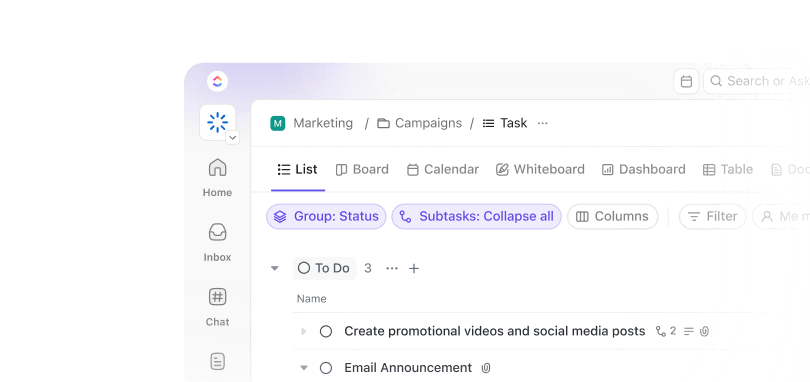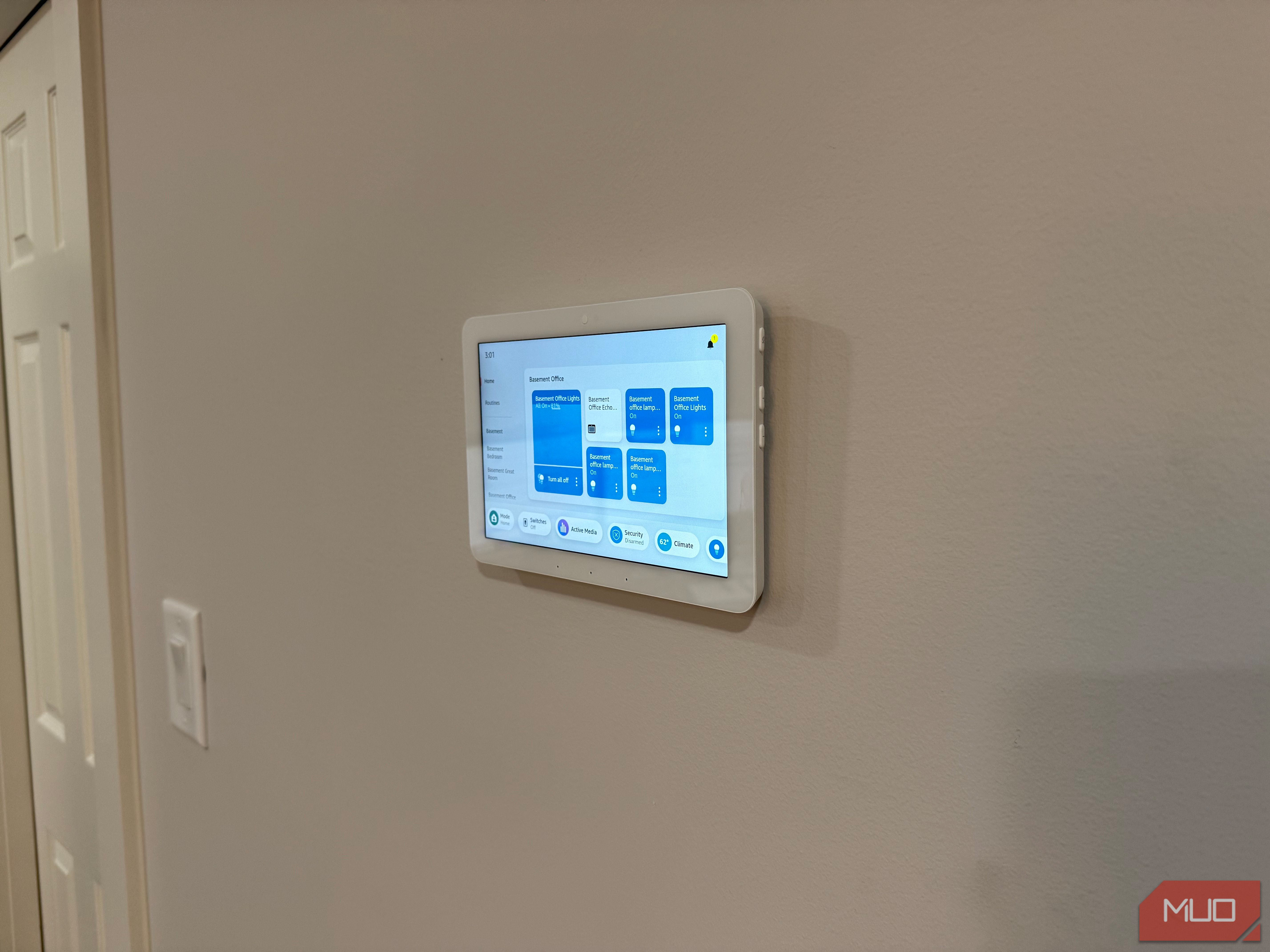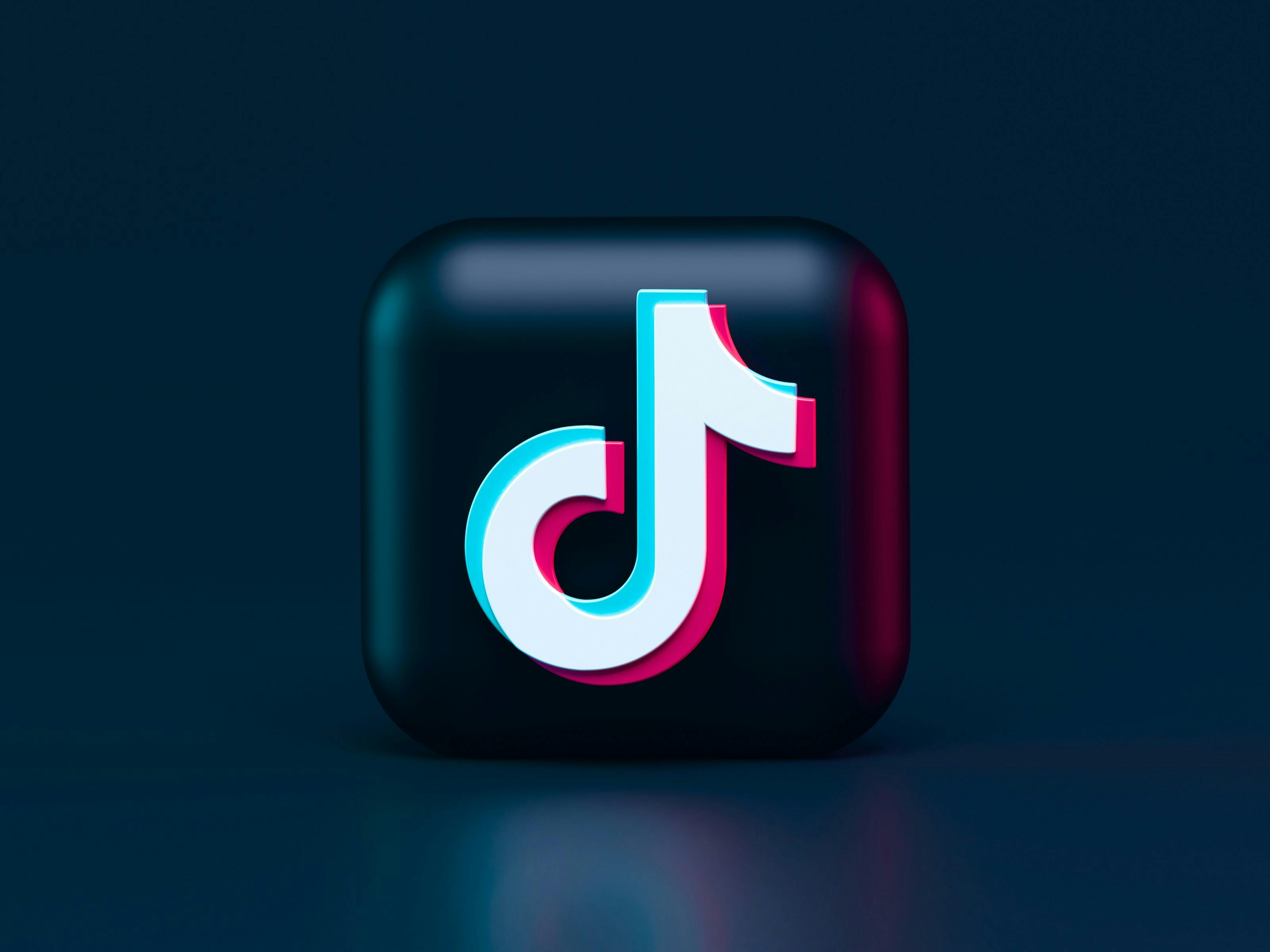Halfway through the quarter, the numbers didn’t add up. The budget said one thing, the spreadsheet another, and the finance team had a third version altogether. No one was wrong, but no one had the whole picture either.
If you’ve dealt with scattered cost data or late-stage budget surprises, you know how quickly things spiral without the proper setup. The fix? Tools built to track costs as the project moves.
Here are the top project cost tracking software tools that bring clarity to budgets and forecasts. Let’s get started! 💰
10 Best Project Cost Tracking Software Tools
The Best Project Cost Tracking Software at a Glance
Before you dive in, here’s a quick side-by-side look at the top project management software for cost tracking. 💸
| Tool | Best for | Best features | Pricing* |
| Centralized cost tracking within live project workflows for individuals, mid-market companies, and large enterprises | Task-level cost tracking with Custom Fields, budget vs. actuals analysis in Dashboards, automated cost alerts, time tracking, AI and automation | Free forever; Customization available for enterprises | |
| Productive | Agency profitability tracking from quote to invoice for mid-market teams and growing agencies | Real-time budget and profitability tracking, custom billing rates, detailed financial reporting, AI assistance | Free trial available; Plans start at $11/month |
| Screendragon | Campaign cost management in creative marketing workflows for marketing departments and in-house creative teams | Multi-channel spend tracking, ROI-based reporting, automated budget approvals, AI assistance | Custom pricing |
| Wrike | Complex cross-departmental cost oversight for enterprise project teams and consultants | Project budget templates, automated time tracking, phase-level profitability reporting, AI assistance | Free plan available; Paid plans start at $10/month per user |
| Smartsheet | Spreadsheet-based budgeting with real-time collaboration for small teams and finance-focused users | Spend alerts, roll-up reports, audit trails, collaborative cost planning sheets, AI assistance | Free plan available; Paid plans start at $12/month per user |
| Toggl Track | Simple time-based budgeting with no-frills setup for freelancers and lean project teams | Project time tracking with budget alerts, productivity analysis reports | Free plan available (up to 5 users); Paid plans start at $10/month per user |
| Harvest | Time tracking linked directly to billing and revenue for consultants and client-service teams | Time logs, profitability reports by client/project, burn-rate forecasting | Free plan available; Paid plans start at $13.75/month per user |
| Hubstaff | Time and cost management and monitoring for distributed teams and remote-first companies | Employee productivity tracking, project-based cost tracking, payroll integration | Free trial available; Plans start at $7/month per user |
| Sage Intacct | Integrating cost tracking for finance teams at large enterprises | Project budgets linked to general ledger, real-time expense governance, multi-dimensional profitability reporting, AI assistance | Custom pricing |
| Procore | Full-spectrum project cost control for large construction firms and general contractors | Construction-specific cost codes, field-to-finance sync, automated change order management, detailed reporting, AI assistance | Custom pricing |
How to Choose Project Cost Tracking Software?
When selecting project cost tracking software, prioritize features that streamline financial management and support project success. Consider these capabilities for your preferred cost management tools:
- Real-time budget management: Monitor expenses against budgets instantly to stay on top of costs
- Detailed reporting and analytics: Gain insights into cost trends and variances with robust time tracking reports
- Seamless integrations: Connect with accounting software or enterprise resource planning (ERP) systems to reduce manual data entry
- Strong security features: Protect your project cost data with encryption and role-based access controls
- Scalability: Adapt to growing project or organizational needs with ease
- Mobile access: Enable on-the-go updates for remote and deskless team members, facilitating seamless project execution
- Automated alerts: Receive notifications for budget overruns to prevent surprises during the project lifecycle
- Multi-currency support: Facilitate global projects with diverse currency options for effective project cost management
💡 Pro Tip: Use a ‘spend shadow’ log to track informal costs, like team lunches or ad-hoc tools, so you can see how these small expenses add up and set a cap.
📊 Budget Blunder: Montreal’s Olympic Stadium was initially budgeted at $134 million CAD but ended up costing over $1.6 billion CAD. Poor financial oversight and political interference made it a 30-year debt burden.
The Best Project Budgeting & Cost Tracking Software
Here’s a look at some of the best project cost tracking software built to handle real team workflows. 📑
1. (Best for centralized cost tracking within project workflows)
Tracking project costs in isolation often leads to delays, overspending, or missed approvals. Teams switch between spreadsheets, email chains, and time-tracking apps—none of which connect back to the actual work.
brings everything into one space, so cost tracking becomes part of the project, not an afterthought.
💵 Build financial details into tasks
Tasks makes it easy to track financial updates at the task level.
Let’s say an event agency is coordinating a large conference. Each task—venue booking, speaker coordination, vendor management—can include cost notes, vendor invoices, and real-time status updates. Finance and project teams can tag each other, leave comments, and confirm payments without the toggle tax.
Layer in Custom Fields to turn tasks into budget trackers by adding inputs like ‘Estimated Cost’, ‘Actual Cost’, and ‘Cost Type’.
💵 Track time and outcomes as you work


Project Time Tracking brings labor costs into the picture. Team members track hours per task, and project managers see real-time data so that timelines can be adjusted or overages flagged.
Teams can surface project data through Dashboards, selecting from 50+ widgets to customize them.


For example, a product team managing a major feature rollout might build a dashboard that shows hours logged per team member, budget vs actuals by sprint, and cost breakdowns by task type. This gives everyone from project leads to executives a shared view of financial progress without extra reporting work.
💵 Save time with templates
Project Cost Analysis Template gives teams a ready-made structure for estimating and tracking budgets across milestones. It’s especially useful for teams running projects with fixed scopes or grant-based funding that requires accurate variance tracking.
At the same time, ’s Project Cost Management Template adds more oversight. A digital agency managing several client retainers can use this to assign recurring budget reviews, log client approvals, and compare cost performance across multiple deliverables.
The template keeps everything visible and organized, even when multiple teams are involved.
best features
- Standardize cost intake: Collect budget requests using Forms to standardize submissions across vendors and teams
- Centralize financial documentation: Document budget approval processes in Docs to keep financial policies accessible and up to date
- Get instant budget insights: Use Brain to surface project budgets, expense breakdowns, or pending approvals without digging through tasks
- Track recurring expenses: Set up Recurring Tasks to schedule monthly budget check-ins or recurring vendor payments
- Automate cost alerts: Create Automations to trigger alerts when a task exceeds estimated costs or a new expense is added
limitations
- While tasks can be updated via mobile, entering or reviewing detailed cost data isn’t as smooth or efficient on smaller screens
pricing
free forever
Best for personal use
Free Free
Key Features:
unlimited
Best for small teams
$7 $10
Everything in Free Forever plus:
business
Best for mid-sized teams
$12 $19
Everything in Unlimited, plus:
enterprise
Best for many large teams
Get a custom demo and see how aligns with your goals.
Everything in Business, plus:
* Prices when billed annually
The world’s most complete work AI, starting at $9 per month
Brain is a no Brainer. One AI to manage your work, at a fraction of the cost.
Try for free
ratings and reviews
- G2: 4.7/5 (10,400+ reviews)
- Capterra: 4.6/5 (4,470+ reviews)
What are real-life users saying about ?
This G2 review really says it all about as a project cost tracking software:
📮 Insight: 16% of managers struggle with integrating updates from multiple tools into a cohesive view. When updates are scattered, you end up spending more time piecing together information and less time leading.
The result? Unnecessary administrative burdens, missed insights, and misalignment. With ’s all-in-one workspace, managers can centralize tasks, documents, and updates, reducing busywork and surfacing the insights that matter most, right when they’re needed.
💫 Real Results: Convene unified 200 professionals into one workspace, using customizable templates and time tracking to reduce overhead and improve delivery times across multiple locations.
2. Productive (Best for creative agencies tracking profitability)
Creative agencies often struggle to figure out which projects actually make money. Productive solves this through real-time profitability tracking that shows where your agency stands financially on every single project.
The platform connects time tracking directly to budgets, allowing you to monitor profit margins as work progresses. What makes this tool different from generic project managers is its deep understanding of agency workflows, from client onboarding to final billing.
Productive best features
- Track billable hours against project budgets in real time and receive instant alerts when you approach spending limits or profitability thresholds
- Generate comprehensive financial reports that break down costs across different project phases, team members, and client segments
- Autofill expense forms, generate reports, and summarize task activities with Productive AI
- Create custom billing rates for different team members, project types, and client tiers
- Monitor team capacity and resource leveling across multiple projects to prevent overcommitment
Productive limitations
- The integration ecosystem is smaller compared to enterprise-level competitors like
- Custom reporting requires technical knowledge to set up effectively, which can be challenging for smaller teams without dedicated IT support
Productive pricing
- Free trial
- Essential: $11/month
- Professional: $28/month
- Ultimate: $39/month
Productive ratings and reviews
- G2: 4.7/5 (60+ reviews)
- Capterra: 4.6/5 (95+ reviews)
What are real-life users saying about Productive?
Here’s a G2 reviewer’s take on Productive’s project cost management tools:
3. Screendragon (Best for marketing teams managing campaign budgets)
Ever tried managing a complex marketing campaign while keeping track of every dollar spent? Screendragon tackles this challenge through purpose-built workflow automation designed specifically for marketing teams. It seamlessly handles creative approval processes that typically create bottlenecks in campaign execution.
Teams can set up automated routing that keeps projects moving while maintaining complete budget visibility. This way, you can see exactly how much each stage of campaign development costs and optimize accordingly.
Screendragon best features
- Track campaign spending across multiple channels, vendors, and media types in a unified dashboard
- Set up custom budget categories that align perfectly with marketing campaign structures
- Generate detailed ROI reports that connect campaign spending to performance metrics, helping you identify which investments deliver the highest returns
- Leverage AI assistance to pull operational and resource insights, create on-brand content, and build agentic workflows
- Gain a complete view of resource capacity for effective resource management
Screendragon limitations
- Interface design feels outdated compared to newer marketing project management tools
- Customizations and advanced features often require assistance from Screendragon’s support team, which can slow down implementation
Screendragon pricing
Screendragon ratings and reviews
- G2: 4.7/5 (100+ reviews)
- Capterra: 4.7/5 (30+ reviews)
💡 Pro Tip: Create a ‘spend velocity’ metric to measure how fast each team burns through its budget. This is great for spotting inefficiencies, like a team overusing contractor hours.
4. Wrike (Best for complex projects requiring detailed oversight)
Complex projects have a way of spiraling out of control, especially when multiple departments need to collaborate on deliverables. Wrike approaches this through customizable workflows that adapt to virtually any project structure while maintaining detailed cost tracking throughout.
Teams particularly appreciate the platform’s ability to handle enterprise-level complexity without sacrificing visibility into project costs and resource utilization.
Wrike best features
- Create detailed project budget templates that include predefined categories, approval processes, and cost tracking parameters
- Estimate, allocate, and track financials in real time for all projects in one place with the budgeting feature
- Generate comprehensive reports that analyze project profitability across different dimensions
- Set up automated time tracking and expense reporting that integrates directly into project budgets
- Get quick answers to project queries and generate project updates with Wrike AI
Wrike limitations
- It lacks built-in screen sharing, messaging, or video conferencing, forcing reliance on external tools for real-time collaboration
- Users report slow loading times or glitches, such as pages failing to load after being idle
- Advanced financial management, such as invoicing or expense tracking, often requires integration with other software
Wrike pricing
- Free
- Team: $10/month per user (billed annually)
- Business: $25/month per user (billed annually)
- Enterprise: Custom pricing
- Pinnacle: Custom pricing
Wrike ratings and reviews
- G2: 4.2/5 (4,400+ reviews)
- Capterra: 4.4/5 (2,810+ reviews)
5. Smartsheet (Best for spreadsheet lovers managing project finances)
If your team lives and breathes spreadsheets but needs more sophisticated project tracking capabilities, Smartsheet perfectly bridges that gap. It combines the familiar grid interface everyone knows how to use with powerful project management features that effectively track costs.
Teams can build complex project budgets using spreadsheet formulas while accessing advanced features like automated workflows and real-time collaboration.
You can use it to track expenses, monitor resource costs, and create roll-up reports that consolidate financial data from multiple projects.
Smartsheet best features
- Generate executive-level financial reports that look and feel like traditional spreadsheets but pull data from live project tracking
- Use AI to analyze your sheets and generate insights and predict trends in project spending
- Allocate resources, track their utilization rates, and calculate labor costs based on assigned tasks and hourly rates
- Set up conditional formatting and automated alerts that highlight budget variances, overruns, and resource allocation issues
- Collaborate on project budgets and financial planning through shared sheets, where multiple team members can input data while maintaining complete audit trails
Smartsheet limitations
- Changes don’t always update in real time, and there’s no automatic saving
- Reports are capped at 500 rows per page, and navigating large reports can be tedious
- Some users report inadequate security features, like unclear data storage locations or a lack of a ‘super admin’ role for full sheet access
Smartsheet pricing
- Free trial
- Pro: $12/month per user
- Business: $24/month per user
- Enterprise: Custom pricing
- Advanced Work Management: Custom pricing
Smartsheet ratings and reviews
- G2: 4.4/5 (19,680+ reviews)
- Capterra: 4.5/5 (3,450+ reviews)
What are real-life users saying about Smartsheet?
Here’s a firsthand perspective on this project cost tracking software from a G2 review:
6. Toggl Track (Best for simple time tracking across projects)
Sometimes you just need to know where your time goes without dealing with complicated project management overhead. Toggl Track delivers that through dead-simple time tracking that works across any device or platform.
This tool is designed to get out of your way—start a timer, assign it to a project, and stop when you’re done. No complicated workflows or mandatory fields that slow down your actual work. Teams love how the detailed reports reveal patterns in time usage that directly impact project profitability.
Toggl Track best features
- Set up project budgets based on time estimates and receive alerts when tracked time approaches or exceeds allocated hours
- Track time offline and sync automatically when you reconnect, ensuring you never lose billable hours
- Analyze team productivity patterns through reporting that shows peak performance hours, project efficiency rates, and individual contributor patterns
Toggl Track limitations
- Team management features are basic compared to full project management platforms
- Lacks native invoicing and break logging, GPS tracking, payroll, or scheduling features
- Editing time entries can be cumbersome and prone to errors
- You can’t pause timers; you must stop and restart, leading to fragmented entries (e.g., multiple 5-second sessions)
Toggl Track pricing
- Free (for up to five users)
- Starter: $10/month per user
- Premium: $20/month per user
- Enterprise: Custom pricing
Toggl Track ratings and reviews
- G2: 4.6/5 (1,570+ reviews)
- Capterra: 4.7/5 (2,575+ reviews)
What are real-life users saying about Toggl Track?
This Capterra review brings up an interesting angle:
🔍 Did You Know? Only 41% of organizations mostly or always deliver projects on budget. This highlights a significant gap that cost tracking can help close.
7. Harvest (Best for integrated time tracking and invoicing)
Project managers who need seamless integration between cost tracking and client billing find Harvest particularly valuable. The project budget software connects time tracking directly to invoicing processes, ensuring that all billable hours get captured and converted to revenue efficiently.
Finance teams appreciate how Harvest handles both internal cost tracking and external client billing in one system, reducing reconciliation work between different platforms. The detailed reporting shows which projects and clients generate the highest margins.
Harvest best features
- Set up automated time tracking reminders and weekly summaries that help you maintain consistent tracking habits
- Analyze your business performance through comprehensive reports that show which clients, projects, and work types deliver the highest profitability
- Create accurate project forecasts based on current burn rates and remaining budget allocations to predict final project profitability
- Automatically create invoices from tracked time and expenses and send them to clients directly from the platform
Harvest limitations
- Lacks built-in payroll or automated sales tax features, requiring manual work or third-party integrations
- No centralized notification hub for updates like timesheet submissions or invoice reminders
- Filtering options for tasks or time entries are basic, making it hard to analyze specific categories or groups within reports
Harvest pricing
- Free
- Pro: $13.75/month per user
- Premium: $17.50/month per user
Harvest ratings and reviews
- G2: 4.3/5 (815+ reviews)
- Capterra: 4.6/5 (630+ reviews)
📊 Budget Blunder: In the early 2000s, a British government project to modernize healthcare records ballooned from £2 billion to £12 billion before being scrapped.
8. Hubstaff (Best for remote teams needing detailed activity monitoring)
Operations leaders managing distributed teams need detailed visibility into how remote workers spend time and how that translates to project costs. Hubstaff provides this visibility through comprehensive activity monitoring.
It provides accountability without being overly invasive—team members can see their own productivity patterns while managers get the visibility they need for accurate project costing. The detailed reporting helps identify which remote work patterns lead to the most efficient project delivery.
Hubstaff best features
- Monitor team productivity through automatic screenshot capture and application usage tracking
- Track project costs in real time as team members work, with automatic labor cost calculation based on individual hourly rates and actual time investment
- Set weekly budgets or fixed cost limits for projects and team members to prevent overspending
- Set up automated payroll processing based on tracked hours and project assignments, streamlining payment processes
- View detailed reports on project costs, team member spending, and budget history.
Hubstaff limitations
- Employee monitoring features can feel invasive and may hurt team morale if not implemented thoughtfully, besides being unsuitable for tracking creative or strategic work
- Privacy concerns may limit adoption in organizations with strict data protection requirements
- Its strength is primarily in labor cost management; it’s less equipped to handle material costs or other non-labor project expenses
Hubstaff pricing
- Free trial
- Starter: $7/month per user (two seats minimum)
- Grow: $9/month per user (two seats minimum)
- Team: $12/month per user (two seats minimum)
- Enterprise: $25/month per user
Hubstaff ratings and reviews
- G2: 4.2/5 (1,440+ reviews)
- Capterra: 4.6/5 (1,570+ reviews)
What are real-life users saying about Hubstaff?
One G2 review puts it this way:
9. Sage Intacct (Best for enterprise financial management integration)
Enterprise organizations need project cost tracking that integrates seamlessly into existing financial systems and reporting structures. Sage Intacct delivers this through comprehensive financial management capabilities.
It excels at project accounting, allowing you to track and manage costs, billings, and revenue for each project with a high degree of precision. You can allocate direct and indirect costs, manage complex billing schedules, and recognize revenue according to accounting standards.
Finance teams can finally get accurate project profitability data that feeds directly into corporate financial statements and executive reporting without manual data manipulation.
Sage Intacct best features
- Create sophisticated project budgets that connect to general ledger accounts and automatically update financial statements
- Tag transactions with project, department, location, and other dimensions for granular financial analysis and reporting
- Set up automated financial controls that require approvals for any project expenses exceeding predetermined thresholds
- Track project costs while maintaining complete audit trails that satisfy corporate governance requirements and financial reporting standards
- Improve data quality and automate complex financial workflows with integrated AI
Sage Intacct limitations
- Implementation complexity requires significant IT resources and financial expertise to configure properly
- Pricing is substantially higher than that of simpler project management tools, making it impractical for smaller organizations
- Overkill for organizations that don’t need comprehensive financial management integration alongside project tracking
- Due to GAAP compliance, configurations are rigid after implementation, requiring developer or reseller assistance for changes
Sage Intacct pricing
Sage Intacct ratings and reviews
- G2: 4.3/5 (3,730+ reviews)
- Capterra: 4.3/5 (525+ reviews)
💡 Pro Tip: Implement a quick spend veto process where any non-critical expense over a set threshold needs a second sign-off to prevent impulse purchases. You can build an AI Agent in to automate this for you.
📊 Budget Blunder: California’s High-Speed Rail project was projected at $33 billion in 2008. By 2023, estimated costs had reached $128 billion with no clear completion date. This was largely blamed on inconsistent cost monitoring and scope shifts.
10. Procore (Best for construction project cost management)
Construction involves unique project cost management challenges that generic tools simply can’t handle effectively. Procore addresses these specific needs through purpose-built features for construction project financial management.
It understands how construction costs flow and provides visibility at every stage, from pre-development to closeout. Teams can track labor, materials, equipment, and subcontractor costs while adhering to construction accounting principles and reporting requirements.
Procore best features
- Manage change orders and budget modifications through automated approval workflows that maintain complete audit trails
- Access budgets, contracts, change orders, purchase orders, and invoices all in one connected system with built-in AI assistance
- Generate detailed cost reports that break down project expenses by trade, phase, cost code, and other construction-specific categories
- Connect field operations directly to financial tracking through mobile apps that allow crews to log time, materials, and equipment usage from job sites
Procore limitations
- The preconstruction bidding tool is criticized for being inefficient and problematic, with issues like poor usability and a lack of timely updates from the development team
- Implementation requires substantial setup time to configure cost codes, approval workflows, and integration with existing accounting systems
- Some users experience inadequate customer support, with slow response times, a lack of dedicated account managers, or unresolved issues
Procore pricing
Procore ratings and reviews
- G2: 4.6/5 (3,450+ reviews)
- Capterra: 4.5/5 (2,770+ reviews)
What are real-life users saying about Procore?
A Capterra review summed it up like this:
💡 Pro Tip: To simplify software cost reduction, track feature creep expenses separately. Try logging any add-on requests against the original scope, so you can negotiate or defer them to stay within budget.
See the Full Cost Picture in
Budget tracking often happens in a silo. Teams update spreadsheets, numbers get passed around, and project visibility suffers.
closes that gap. This project cost tracking software helps teams monitor project budgets without losing momentum on tasks or timelines.
With task management, reports, documents, and communication in one connected platform, budgets stay connected to the work. Naturally, decisions happen faster, and projects stay on track.
Sign up for today! ✅


Everything you need to stay organized and get work done.














